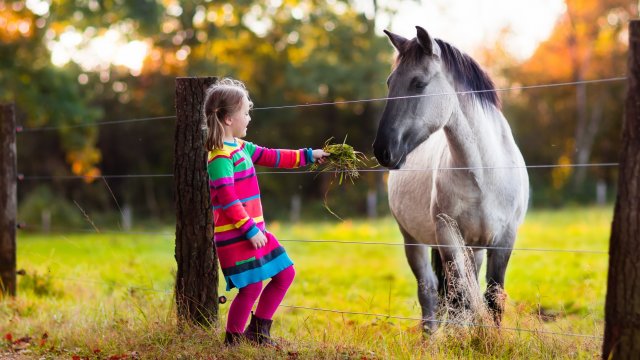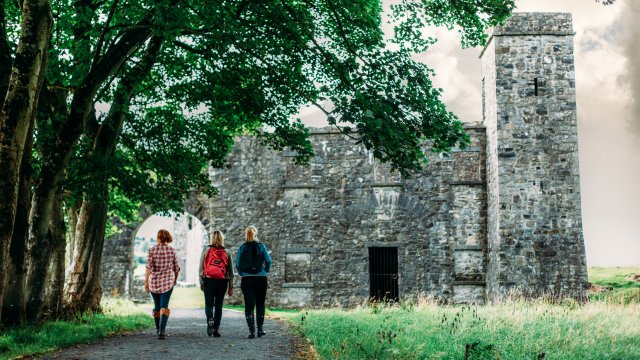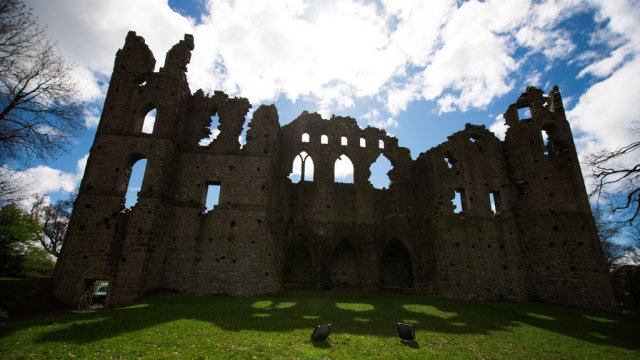



Ancient Sites
The Hill of Uisneach
The Hill of Uisneach, situated between the villages of Ballymore and Loughanavally, was the ancient seat of the Kings of Meath. Its roots stretch back into ancient mythology with its history rooted in a La Tene period of the Iron Age and it has been placed in the same league as the Hill of Tara in neighbouring County Meath.
Uisneach has also been famous as a meeting place in pre history as a place of cattle rituals and other ‘May Day’ assemblies, and in more recent times as the meeting place for an important twelfth century synod. St. Patrick and St. Brigid have important connections with the Hill, it being claimed that it was here St. Brigid received the veil from St. Patrick.
The importance of Uisneach in early times is reflected in the large number of monuments – almost twenty – mostly ring forts and tumuli which are scattered around and upon it. it was said to be linked to Tara by a chariot road and many of the town-lands which impinge on the hill re named for the remaining features such as Meawira meaning “the bald fort” or more likely “the dismantled fort”, Rathnew or “the new fort” and Togherstown meaning “the town of the causeway”. The most famous feature on Uisneach is the CAT STONE, named so because it resembles a cat watching a mouse. It is a huge limestone boulder almost six metres high which is estimated to weigh over 30 ton and is said to mark the centre ofIrelandor the coming together of the provinces.
The Hill of Uisneach is located in the Heart of Ireland in County Westmeath and is unique in that one can view more counties from this hill than any other – 21 in total. Situated on the exact centre point of the island, it was the ancient home of the Goddess Ériu and the true residence of the High Kings of Ireland. Over the centuries Uisneach was a busy, bustling place where all clans, tribes, chiefs and faiths came together at Ériu’s burial place – Aill na Mireann, or the ‘Catstone’ - to pass laws, trade and renew allegiance to each other. Each May they gathered to praise Ériu and celebrate the arrival of summer with the Bealtaine festival. Traders from around the world came and practically every mythology features some mention of this festival. Artefacts from the Middle East andAfghanistanhave been found in archaeological digs, and the Hill was mentioned in many pre-Christian texts. Even Caesar spoke of the festival.
In more recent times, Uisneach was an important meeting and rallying place. An important 12th Century Christian Synod took place here, whilst the likes of St. Patrick and St. Brigid, Brian Boru, Fionn MacChumaill and the notorious O’Neill clan all have connections to the hill. Eamon De Valera, Padraic Pearse and Daniel O’Connell all addressed rallies there, and James Joyce, pop star Michael Jackson and the leader of the Sioux Nation have all visited.
Some forty monuments are scattered upon the Hill, each with a unique story to tell. We hope to tell these stories, and make a bit of new history on this most historic and important site.
Address: Killare, County Westmeath
Tel: 0877189550
Web: www.uisneach.ie
Fore Abbey
In a tranquil, green valley in thevillageofFore, about a 30-minute drive from Mullingar in County Westmeath, visitors can view the site where St Fechin founded a Christian monastery in the 7th Century. It’s believed that before his death, 300 monks lived in the community. Later, the monastery was set fire 12 times.
Among the remains, visitors can see St Fechin’s church, built about 900. They will also find one of the 18 Fore crosses, which are spread out over 10km on roadways and in fields.
The Seven Wonders of Fore include, the monastery in the bog, the mill without a race, the water that flows uphill, the tree that has three branches/the tree that won’t burn, the water that won’t boil, the anchorite in a stone and the stone/lintel raised by St Fechin’s prayers.
Address: Fore, County Westmeath
Telephone: +353 (0)44 9661780
Clonmacnoise
An Early Christian site founded by St. Ciarán in the mid-6th century on the eastern bank of the River Shannon. The site includes the ruins of a cathedral, seven churches (10th -13th century), two round towers, three high crosses and the largest collection of Early Christian graveslabs inWestern Europe. The original high crosses and a selection of graveslabs are on display in the visitor centre. The long and varied history of Clonmacnoise is recounted in an audiovisual presentation shown in the visitor centre. There are also exhibitions that deal with the flora, fauna and landscape of the region.
Please note that this is a very busy site and visitors may experience a delay during the summer months.
Address: Clonmacnoise, Shannonbridge, Athlone, Co. Offaly.
Tel: +353 90 9674195.
E-mail: clonmacnoise@opw.ie
Clara Bog Nature Reserve & Visitor Centre
Clara Bog is perhaps the best remaining example of midland raised bog inWestern Europe. It has been said that you can experience ten thousand years of history in the ten square miles that accommodate Clara Bog.
Clara Bog also contains fine examples of hummocks, hollows, lawns, pools and flushes; all classic components of a raised bog.
The centre offers guided walks and educational activities for adults and children.
Tel: 057 9368878
Email: claraguides@ahg.gov.ie
Dún na Sí Amenity & Heritage Park
Set in a stunning 27 acre parkland nestling in the Heart of Ireland, Dún na Sí Amenity and Heritage Park boasts an exciting range of recreational, educational, environmental, cultural and historical activities.
The original Dún na Sí Centre opened in 1985 and operated successfully over the years. Midlands Amenity Park Association commenced work on a 23 acre park adjoining Dún na Sí in 2008. Both groups have worked tirelessly to create what is now Dún na Sí Amenity and Heritage Park. The two groups officially merged in 2015. The newly amalgamated parks were officially opened in 2015 by Robbie Henshaw and Senator Labhrás Ó Murchú.
The park comprises of the Scéal Exhibition in the Comhaltas Teach Cheoil, Heritage Trail and Vintage Museum, Pet Farm, Walking Trails, Native Irish Woodland, Turlough, Playground and Tea Rooms. Trace your Westmeath Roots in the Genealogy Centre. Explore reconstructed historical sites depicting life in Ancient Ireland in the Heritage Park. There is a whole day of fantastic activities in store for visitors of all ages so come and see for yourself!
- HeritagePark
- Walking Trails
- VintageMuseum
- Sculpture Trail
- Pet Farm
- Tea Rooms
- Genealogy Centre
- Playground
- Turlough
- Bird Watching
Learn an Irish dance at the Teach Ceoil!
Scéal Exhibition - The Story of Traditional Irish Music
Address: Dún na Sí Amenity & Heritage Park, Moate, Co. Westmeath, N37 P271
Phone: +353 90 6481183
Email: dunnasimoate@eircom.net
Web: www.dunnasi.ie
Bord na Móna Lough Boora Discovery Park
For centuries Lough Boora has given humans shelter, warmth and a unique contact with the forces of the natural world. History, ancient and modern, is around you and under your feet when you visit Lough Boora.
Get away from it all and explore the unique beauty of Lough Boora Discovery Park. Relax with friends and family amidst breathtaking landscapes. Enjoy the simple things and spend quality time making memories to treasure. Connect with nature to revitalise mind and body. There’s a variety of things to see and do at Lough Boora Discovery Park. It’s a family friendly environment with a host of free activities for all ages. There are picnic and play areas and a fairy trail which are all accessible for buggies and wheelchair users. Why not hire a bike and explore the sculpture part? Enjoy walking on the many off road trails.
Address: Lough Boora Discovery Park, Visitor Centre, Boora, Co Offaly, Ireland
Phone: 0579340010
Email: info@loughboora.com
Web: www.loughboora.com



